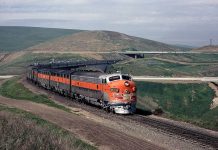A coupling (or a coupler) is a mechanism for connecting rolling stock in a train. The design of the coupler is standard, and is almost as important as the track gauge, since flexibility and convenience are maximised if all rolling stock can be coupled together.
The equipment that connects the couplings to the rolling stock is known as the draft gear or draw gear.
Compatible and simular couplings or couplers are frequently referred to using widely differing make, brand, regional or nick names, which can make describing standard or typical designs confusing. Dimensions and ratings noted in these articles are usually of nominal or typical components and systems, though standards and practices also vary widely with railway, region, and era.
How to Couple a Train in Indian Railways – VIDEO
Puri-Sainagar Shirdi weekly express up train after reaching its destination, preparing for its down journey. Coupling of WAP7 with ICF coaches
Video – Prateek Panda.
The basic type of coupling on railways following the British tradition is the buffer and chain coupling. A large chain of three links connects hooks on the adjoining wagons. These couplings followed earlier tramway practice but were made more regular. Buffers on the frame of the wagon absorbed impact loads, as the train over-ran a slowing locomotive.
The simple chain could not be tensioned and this slack coupling allowed a lot of back-and-forth movement and banging between vehicles. Acceptable for mineral wagons, this gave an uncomfortable ride for passenger coaches, and so the chain was improved by replacing the centre link with a turnbuckle that draws the vehicles together, giving the screw coupling.
A simplified version of this, quicker to attach and detach, still used three links but with the centre link given a T-shaped slot. This could be turned lengthwise to lengthen it, allowing coupling, then turned vertically to the shorter slot position, holding the wagons more tightly together.
Higher speeds associated with fully-fitted freight made the screw-tensioned form a necessity.
The earliest ‘dumb buffers’ were fixed extensions of the wooden wagon frames, but later spring buffers were introduced. The first of these were stiff cushions of leather-covered horsehair, later steel springs and then hydraulic damping.
This coupling is still widespread.



















